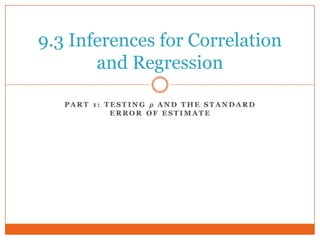
9.3 Part 1
- 1. 9.3 Inferences for Correlation and Regression
- 2. Inferences for Correlation and Regression
- 3. Inferences for Correlation and Regression
- 4. Testing the Correlation Coefficient The first topic we want to study is the statistical significance of the sample correlation coefficient r. To do this, we construct a statistical test of , the population correlation coefficient.
- 5.
- 6. Do college graduates have an improved chance at a better income? Is there a trend in the general population to support the “learn more, earn more” statement? We suspect the population correlation is positive, let’s test using a 1% level of significance. Consider the following variables: x = percentage of the population 25 or older with at least four years of college and y = percentage growth in per capita income over the past seven years. A random sample of six communities in Ohio gave the information shown Education and Income Growth Percentages Table 9.10
- 7. Solution Caution: Although we have shown that x and y are positively correlated, we have not shown that an increase in education causes an increase in earnings.
- 8. You Try It! x 9.2 10.1 9.0 12.5 8.8 9.1 9.5 y 5.0 4.8 4.5 5.7 5.1 4.6 4.2
- 9. Solution
- 10. Standard Error of Estimate Sometimes a scatter diagram clearly indicates the existence of a linear relationship between x and y, but it can happen that the points are widely scattered about the least-squares line. We need a method (besides just looking) for measuring the spread of a set of points about the least-squares line. There are three common methods of measuring the spread. the coefficient of correlation the coefficient of determination the standard error of estimate
- 11. Standard Error of Estimate The Distance Between Points (x, y) and (x, ) Figure 9.16
- 12. Standard Error of Estimate
- 13. Standard Error of Estimate
- 14. Example June and Jim are partners in the chemistry lab. Their assignment is to determine how much copper sulfate (CuSO4) will dissolve in water at 10, 20, 30, 40, 50, 60, and 70C. Their lab results are shown in Table 9-12, where y is the weight in grams of copper sulfate that will dissolve in 100 grams of water at xC. Sketch a scatter diagram, find the equation of the Lab Results (x = C, y = amount of CuSo4) Table 9.12 least-squares line, and compute Se.
- 15. Solution Scatter Diagram and Least-Squares Line for Chemistry Experiment Figure 9.17